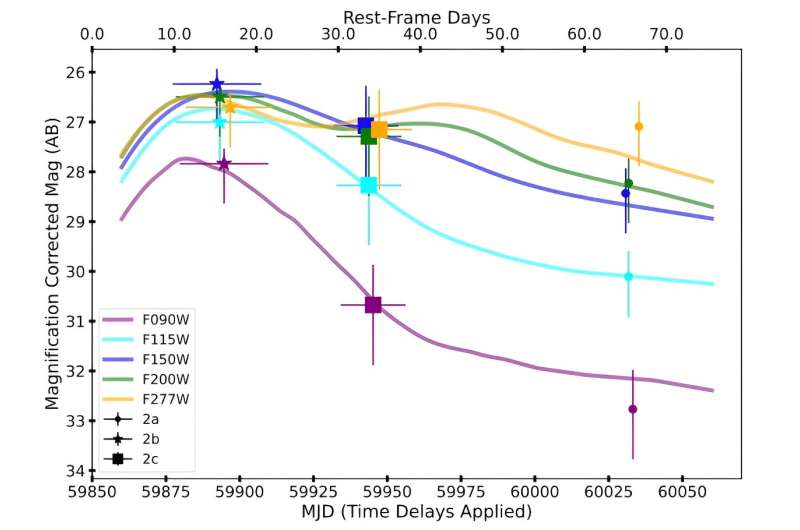September 21, 2023 report
This article has been reviewed according to Science X's editorial process and policies. Editors have highlighted the following attributes while ensuring the content's credibility:
fact-checked
preprint
trusted source
proofread
New Type I supernova discovered with JWST

Using the James Webb Space Telescope (JWST), an international team of astronomers has observed the galaxy cluster PLCK G165.7+67.0. The observational campaign resulted in the detection of a new Type I supernova. The finding is reported in a paper published September 13 on the pre-print server arXiv.
Supernovae (SNe) are powerful and luminous stellar explosions. They are important for the scientific community as they offer essential clues into the evolution of stars and galaxies. In general, SNe are divided into two groups based on their atomic spectra: Type I (no hydrogen in their spectra) and Type II (showcasing hydrogen spectral lines).
Type Ia supernovae (SN Ia) are found in binary systems in which one of the stars is a white dwarf. Stellar explosions of this type are important for the scientific community, as they offer essential clues into the evolution of stars and galaxies.
A group of astronomers led by Brenda L. Frye of the Steward Observatory in Tucson, Arizona, has recently observed PLCK G165.7+67.0 (or G165 for short)—a galaxy cluster at a redshift of 0.35 with a mass of around 200–300 trillion solar masses. During these observations they detected a supernova at a redshift of 1.78 using JWST's Near Infrared Camera (NIRCam). The new supernova, dubbed "SN H0pe," was identified in Arc 2—an infrared-bright galaxy gravitationally amplified by G165.
"The SN is situated 1.5–2 kpc from its host galaxy Arc 2 and appears in three different locations as a result of gravitational lensing by G165. These data can yield a value for Hubble's constant using time delays from this multiply-imaged SN Ia that we call 'SN H0pe,'" the researchers wrote in the paper.
SN H0pe is lensed into three distinct locations, designated SN 2a, 2b, and 2c, therefore it offers a unique opportunity to determine Hubble's constant by measuring the time delays between its multiple images. Further photometric and spectroscopic investigation of SN H0pe confirmed that it is Type Ia supernova.
When it comes to the host galaxy Arc 2, the observations found that it has a stellar mass of about 500 billion solar masses. The results suggest that it has completed a star formation episode about one billion years ago and is now surrounded by star-forming satellite dwarf galaxies.
JWST observations have also shed more light on the properties of G165. According to the paper, G165 has a mass of approximately 260 trillion solar masses and showcases a velocity offset of the brightest cluster galaxy (BCG) from the systemic redshift of the cluster.
Summing up the results, the authors of study noted that they are further inspecting the properties of SN H0pe and more results will be published in the upcoming research paper.
More information: Brenda L. Frye et al, The JWST Discovery of the Triply-imaged Type Ia "Supernova H0pe" and Observations of the Galaxy Cluster PLCK G165.7+67.0, arXiv (2023). DOI: 10.48550/arxiv.2309.07326
Journal information: arXiv
© 2023 Science X Network





















